Impact of L&D Initiatives on SMEs in UAE
VerifiedAdded on 2019/09/13
|59
|13362
|512
Thesis and Dissertation
AI Summary
This dissertation investigates the impact of learning and development (L&D) initiatives on the performance of mid-sized organizations (SMEs) in the UAE, focusing on Synovate Research Company. It employs a mixed-methods approach, using a questionnaire survey of 100 employees and semi-structured interviews with management. The study explores the significance of L&D, examines the initiatives undertaken by Synovate, and analyzes the role of HR in their implementation. The literature review extensively covers talent management, global competencies, challenges faced by SMEs in L&D, and supporting factors. Data analysis reveals a strong positive correlation between L&D initiatives and employee satisfaction, motivation, performance improvement, and organizational performance. The conclusion emphasizes the importance of L&D for SMEs in the UAE, recommending the development of robust HR policies to support effective L&D programs and enhance competitive advantage. The study acknowledges limitations such as the focus on a single company and limited access to financial data.
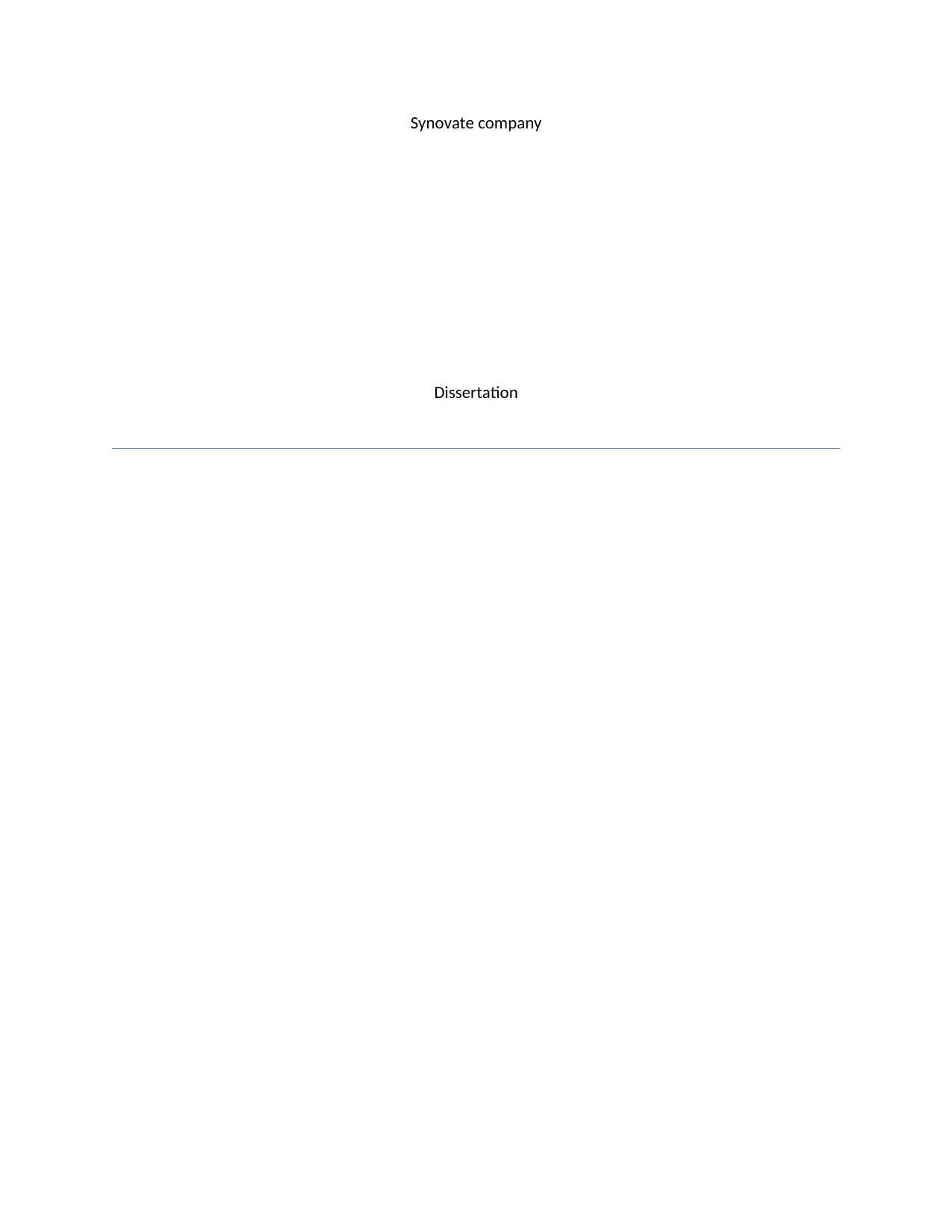
Synovate company
Dissertation
Dissertation
Paraphrase This Document
Need a fresh take? Get an instant paraphrase of this document with our AI Paraphraser

Table of Contents
Chapter-1.........................................................................................................................................3
Introduction......................................................................................................................................3
Background and context of the study...........................................................................................6
Statement of the research problem...............................................................................................7
Research questions.......................................................................................................................8
Aim of study.................................................................................................................................9
Research objective.......................................................................................................................9
Chapter-2.........................................................................................................................................9
Literature review............................................................................................................................10
Importance of training and development programs...................................................................11
Global competencies..................................................................................................................12
Talent management in different sectors and country contexts...................................................16
Meaning of Talent and Talent management..............................................................................17
Challenges faced by companies pertaining training, learning and development initiatives......20
Supporting factors of talent management..................................................................................21
Training attitudes, motivations and expectations.......................................................................22
Training and development in practices......................................................................................23
Training needs analysis and performance appraisal..................................................................24
Influences of training and development strategy and practice...................................................24
Sources of information on training and development................................................................25
Chapter-3.......................................................................................................................................25
Research methodology...................................................................................................................26
Research design..........................................................................................................................26
Research framework and methods.............................................................................................27
Sample........................................................................................................................................27
Participants.................................................................................................................................28
Methods of data generation........................................................................................................28
Research setting.........................................................................................................................31
Negotiation of Access and research ethics.................................................................................32
Chapter-1.........................................................................................................................................3
Introduction......................................................................................................................................3
Background and context of the study...........................................................................................6
Statement of the research problem...............................................................................................7
Research questions.......................................................................................................................8
Aim of study.................................................................................................................................9
Research objective.......................................................................................................................9
Chapter-2.........................................................................................................................................9
Literature review............................................................................................................................10
Importance of training and development programs...................................................................11
Global competencies..................................................................................................................12
Talent management in different sectors and country contexts...................................................16
Meaning of Talent and Talent management..............................................................................17
Challenges faced by companies pertaining training, learning and development initiatives......20
Supporting factors of talent management..................................................................................21
Training attitudes, motivations and expectations.......................................................................22
Training and development in practices......................................................................................23
Training needs analysis and performance appraisal..................................................................24
Influences of training and development strategy and practice...................................................24
Sources of information on training and development................................................................25
Chapter-3.......................................................................................................................................25
Research methodology...................................................................................................................26
Research design..........................................................................................................................26
Research framework and methods.............................................................................................27
Sample........................................................................................................................................27
Participants.................................................................................................................................28
Methods of data generation........................................................................................................28
Research setting.........................................................................................................................31
Negotiation of Access and research ethics.................................................................................32
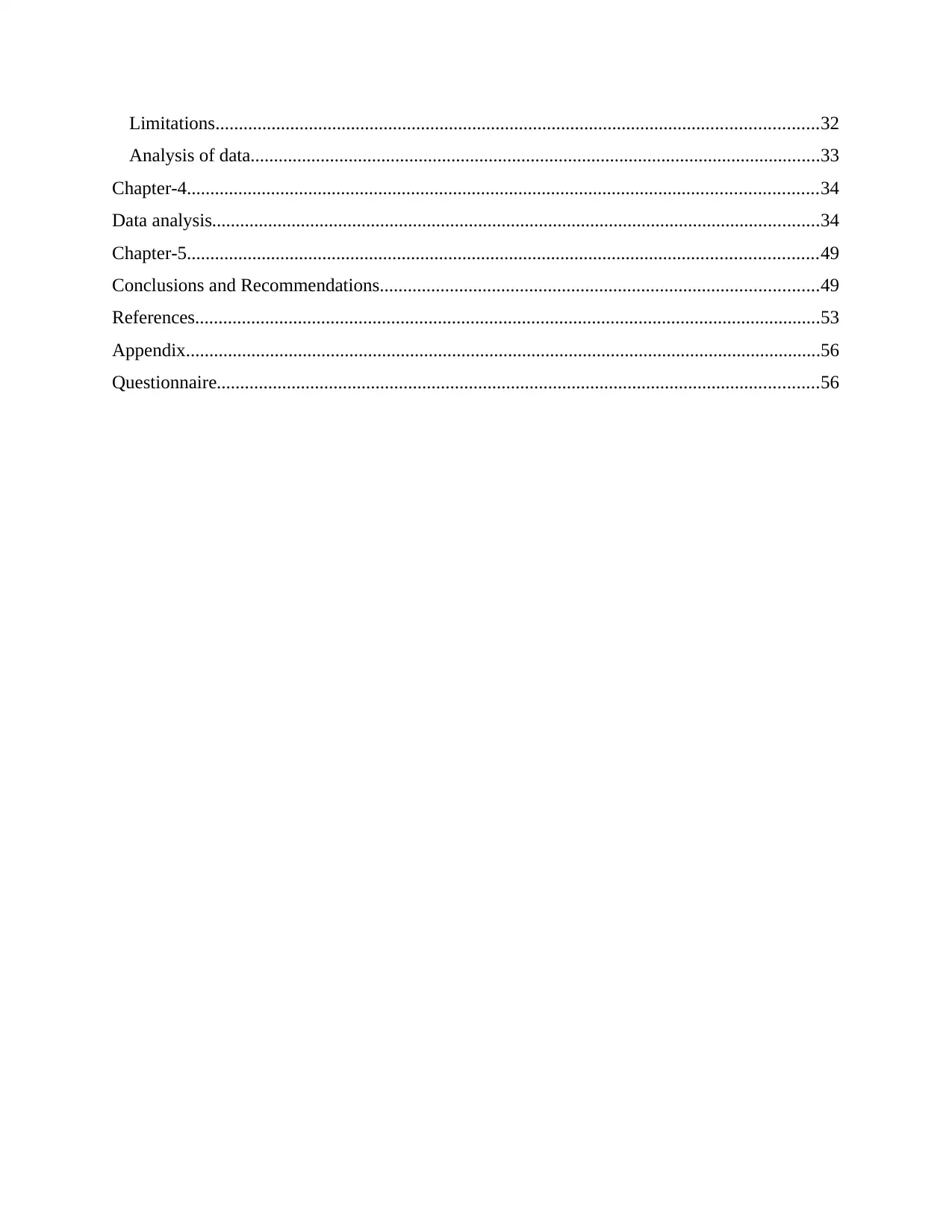
Limitations.................................................................................................................................32
Analysis of data..........................................................................................................................33
Chapter-4.......................................................................................................................................34
Data analysis..................................................................................................................................34
Chapter-5.......................................................................................................................................49
Conclusions and Recommendations..............................................................................................49
References......................................................................................................................................53
Appendix........................................................................................................................................56
Questionnaire.................................................................................................................................56
Analysis of data..........................................................................................................................33
Chapter-4.......................................................................................................................................34
Data analysis..................................................................................................................................34
Chapter-5.......................................................................................................................................49
Conclusions and Recommendations..............................................................................................49
References......................................................................................................................................53
Appendix........................................................................................................................................56
Questionnaire.................................................................................................................................56
⊘ This is a preview!⊘
Do you want full access?
Subscribe today to unlock all pages.

Trusted by 1+ million students worldwide
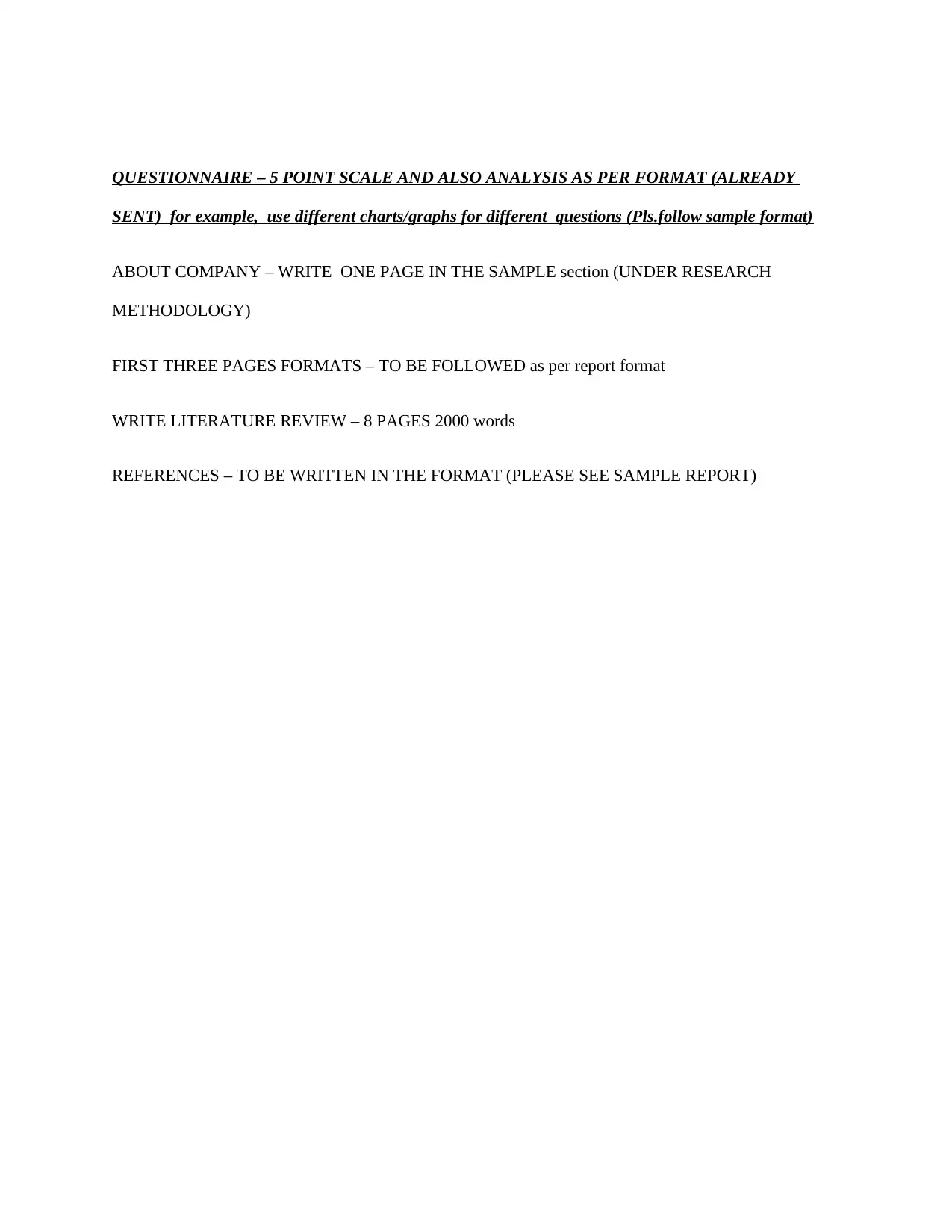
QUESTIONNAIRE – 5 POINT SCALE AND ALSO ANALYSIS AS PER FORMAT (ALREADY
SENT) for example, use different charts/graphs for different questions (Pls.follow sample format)
ABOUT COMPANY – WRITE ONE PAGE IN THE SAMPLE section (UNDER RESEARCH
METHODOLOGY)
FIRST THREE PAGES FORMATS – TO BE FOLLOWED as per report format
WRITE LITERATURE REVIEW – 8 PAGES 2000 words
REFERENCES – TO BE WRITTEN IN THE FORMAT (PLEASE SEE SAMPLE REPORT)
SENT) for example, use different charts/graphs for different questions (Pls.follow sample format)
ABOUT COMPANY – WRITE ONE PAGE IN THE SAMPLE section (UNDER RESEARCH
METHODOLOGY)
FIRST THREE PAGES FORMATS – TO BE FOLLOWED as per report format
WRITE LITERATURE REVIEW – 8 PAGES 2000 words
REFERENCES – TO BE WRITTEN IN THE FORMAT (PLEASE SEE SAMPLE REPORT)
Paraphrase This Document
Need a fresh take? Get an instant paraphrase of this document with our AI Paraphraser
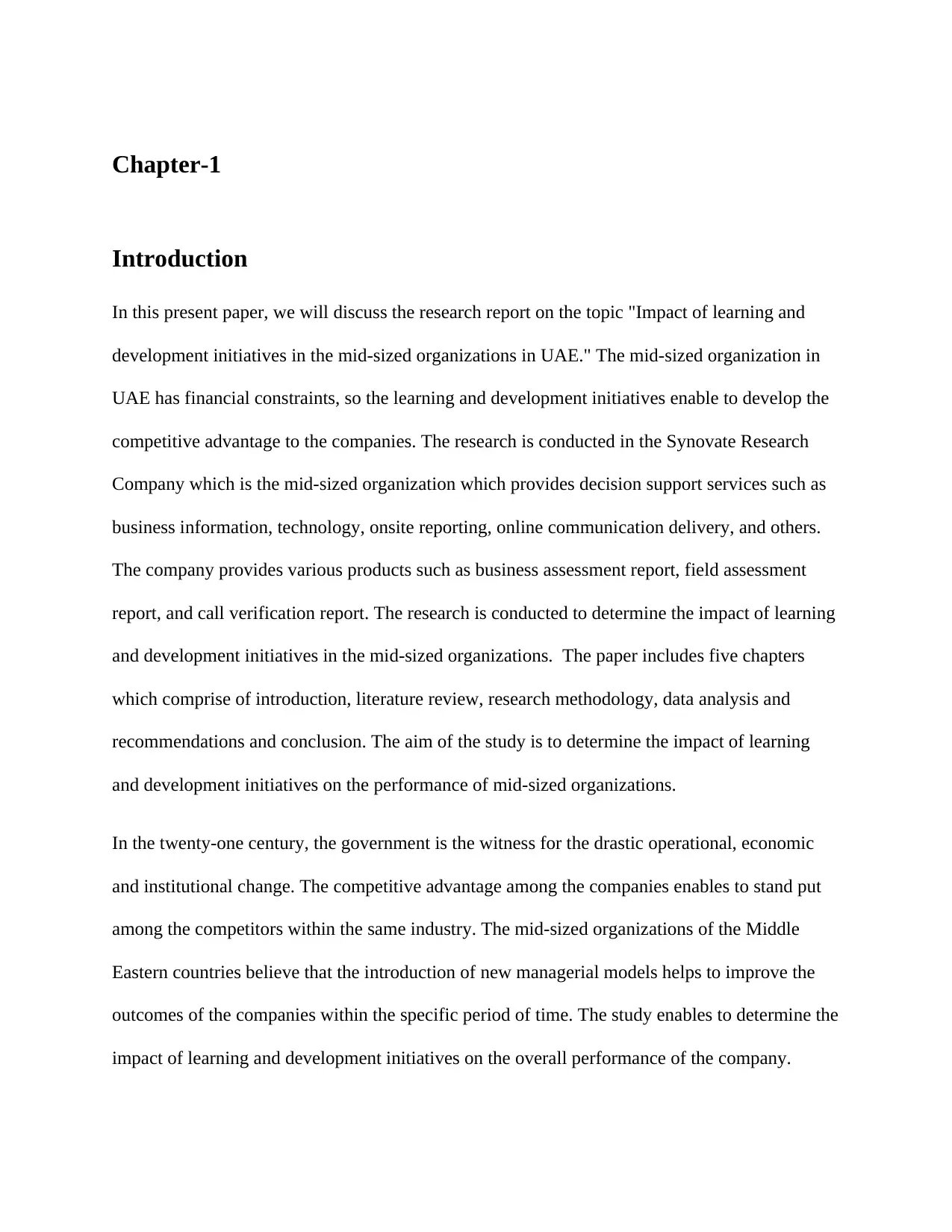
Chapter-1
Introduction
In this present paper, we will discuss the research report on the topic "Impact of learning and
development initiatives in the mid-sized organizations in UAE." The mid-sized organization in
UAE has financial constraints, so the learning and development initiatives enable to develop the
competitive advantage to the companies. The research is conducted in the Synovate Research
Company which is the mid-sized organization which provides decision support services such as
business information, technology, onsite reporting, online communication delivery, and others.
The company provides various products such as business assessment report, field assessment
report, and call verification report. The research is conducted to determine the impact of learning
and development initiatives in the mid-sized organizations. The paper includes five chapters
which comprise of introduction, literature review, research methodology, data analysis and
recommendations and conclusion. The aim of the study is to determine the impact of learning
and development initiatives on the performance of mid-sized organizations.
In the twenty-one century, the government is the witness for the drastic operational, economic
and institutional change. The competitive advantage among the companies enables to stand put
among the competitors within the same industry. The mid-sized organizations of the Middle
Eastern countries believe that the introduction of new managerial models helps to improve the
outcomes of the companies within the specific period of time. The study enables to determine the
impact of learning and development initiatives on the overall performance of the company.
Introduction
In this present paper, we will discuss the research report on the topic "Impact of learning and
development initiatives in the mid-sized organizations in UAE." The mid-sized organization in
UAE has financial constraints, so the learning and development initiatives enable to develop the
competitive advantage to the companies. The research is conducted in the Synovate Research
Company which is the mid-sized organization which provides decision support services such as
business information, technology, onsite reporting, online communication delivery, and others.
The company provides various products such as business assessment report, field assessment
report, and call verification report. The research is conducted to determine the impact of learning
and development initiatives in the mid-sized organizations. The paper includes five chapters
which comprise of introduction, literature review, research methodology, data analysis and
recommendations and conclusion. The aim of the study is to determine the impact of learning
and development initiatives on the performance of mid-sized organizations.
In the twenty-one century, the government is the witness for the drastic operational, economic
and institutional change. The competitive advantage among the companies enables to stand put
among the competitors within the same industry. The mid-sized organizations of the Middle
Eastern countries believe that the introduction of new managerial models helps to improve the
outcomes of the companies within the specific period of time. The study enables to determine the
impact of learning and development initiatives on the overall performance of the company.
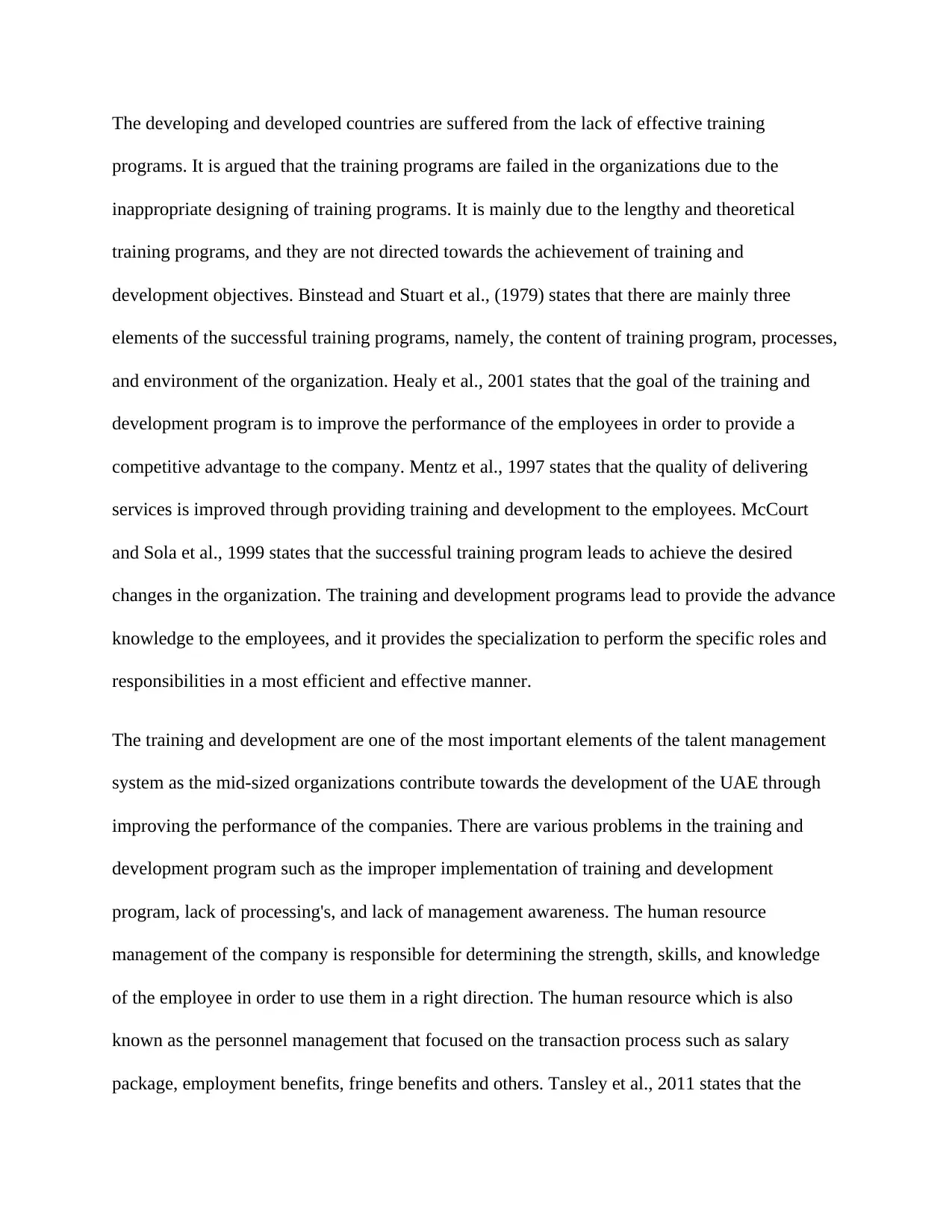
The developing and developed countries are suffered from the lack of effective training
programs. It is argued that the training programs are failed in the organizations due to the
inappropriate designing of training programs. It is mainly due to the lengthy and theoretical
training programs, and they are not directed towards the achievement of training and
development objectives. Binstead and Stuart et al., (1979) states that there are mainly three
elements of the successful training programs, namely, the content of training program, processes,
and environment of the organization. Healy et al., 2001 states that the goal of the training and
development program is to improve the performance of the employees in order to provide a
competitive advantage to the company. Mentz et al., 1997 states that the quality of delivering
services is improved through providing training and development to the employees. McCourt
and Sola et al., 1999 states that the successful training program leads to achieve the desired
changes in the organization. The training and development programs lead to provide the advance
knowledge to the employees, and it provides the specialization to perform the specific roles and
responsibilities in a most efficient and effective manner.
The training and development are one of the most important elements of the talent management
system as the mid-sized organizations contribute towards the development of the UAE through
improving the performance of the companies. There are various problems in the training and
development program such as the improper implementation of training and development
program, lack of processing's, and lack of management awareness. The human resource
management of the company is responsible for determining the strength, skills, and knowledge
of the employee in order to use them in a right direction. The human resource which is also
known as the personnel management that focused on the transaction process such as salary
package, employment benefits, fringe benefits and others. Tansley et al., 2011 states that the
programs. It is argued that the training programs are failed in the organizations due to the
inappropriate designing of training programs. It is mainly due to the lengthy and theoretical
training programs, and they are not directed towards the achievement of training and
development objectives. Binstead and Stuart et al., (1979) states that there are mainly three
elements of the successful training programs, namely, the content of training program, processes,
and environment of the organization. Healy et al., 2001 states that the goal of the training and
development program is to improve the performance of the employees in order to provide a
competitive advantage to the company. Mentz et al., 1997 states that the quality of delivering
services is improved through providing training and development to the employees. McCourt
and Sola et al., 1999 states that the successful training program leads to achieve the desired
changes in the organization. The training and development programs lead to provide the advance
knowledge to the employees, and it provides the specialization to perform the specific roles and
responsibilities in a most efficient and effective manner.
The training and development are one of the most important elements of the talent management
system as the mid-sized organizations contribute towards the development of the UAE through
improving the performance of the companies. There are various problems in the training and
development program such as the improper implementation of training and development
program, lack of processing's, and lack of management awareness. The human resource
management of the company is responsible for determining the strength, skills, and knowledge
of the employee in order to use them in a right direction. The human resource which is also
known as the personnel management that focused on the transaction process such as salary
package, employment benefits, fringe benefits and others. Tansley et al., 2011 states that the
⊘ This is a preview!⊘
Do you want full access?
Subscribe today to unlock all pages.

Trusted by 1+ million students worldwide
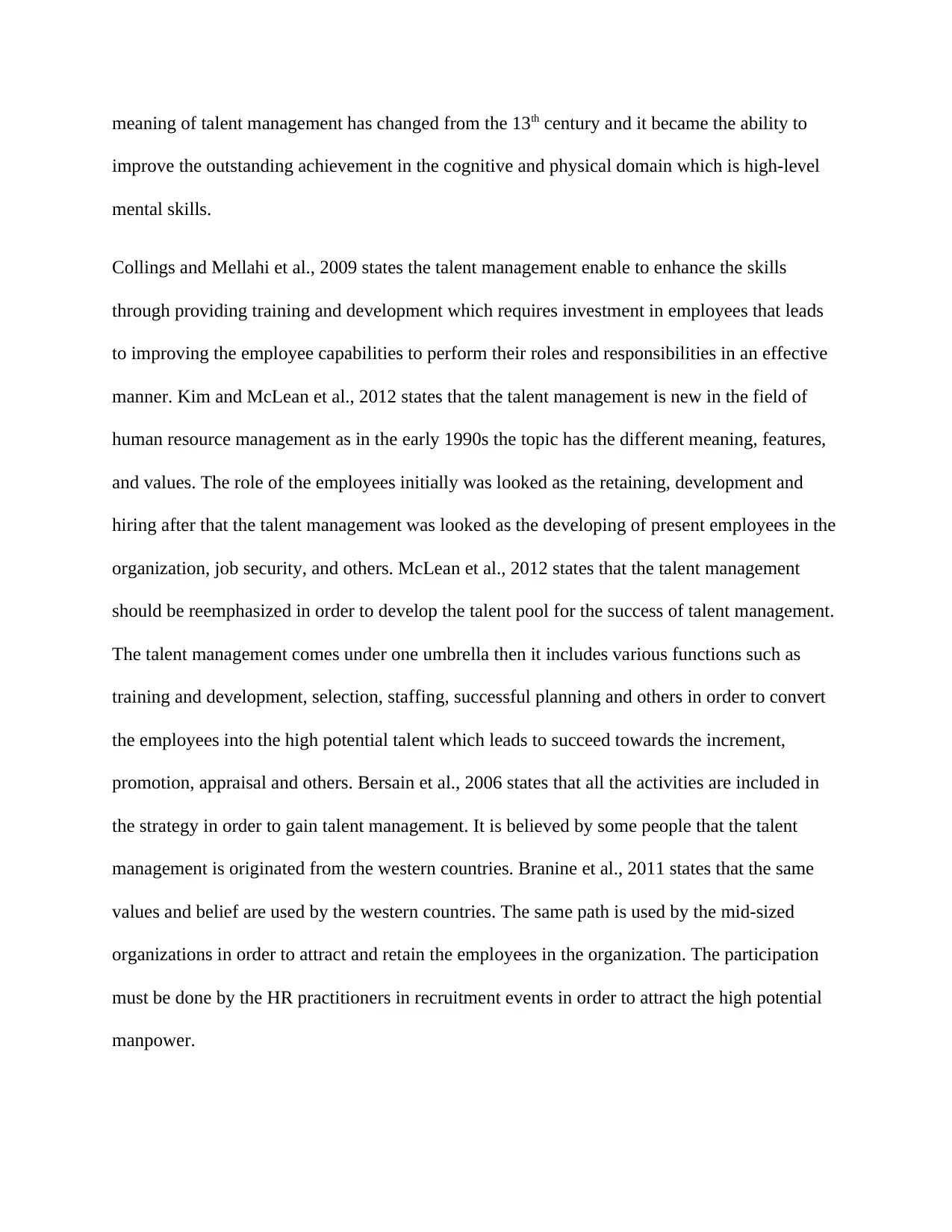
meaning of talent management has changed from the 13th century and it became the ability to
improve the outstanding achievement in the cognitive and physical domain which is high-level
mental skills.
Collings and Mellahi et al., 2009 states the talent management enable to enhance the skills
through providing training and development which requires investment in employees that leads
to improving the employee capabilities to perform their roles and responsibilities in an effective
manner. Kim and McLean et al., 2012 states that the talent management is new in the field of
human resource management as in the early 1990s the topic has the different meaning, features,
and values. The role of the employees initially was looked as the retaining, development and
hiring after that the talent management was looked as the developing of present employees in the
organization, job security, and others. McLean et al., 2012 states that the talent management
should be reemphasized in order to develop the talent pool for the success of talent management.
The talent management comes under one umbrella then it includes various functions such as
training and development, selection, staffing, successful planning and others in order to convert
the employees into the high potential talent which leads to succeed towards the increment,
promotion, appraisal and others. Bersain et al., 2006 states that all the activities are included in
the strategy in order to gain talent management. It is believed by some people that the talent
management is originated from the western countries. Branine et al., 2011 states that the same
values and belief are used by the western countries. The same path is used by the mid-sized
organizations in order to attract and retain the employees in the organization. The participation
must be done by the HR practitioners in recruitment events in order to attract the high potential
manpower.
improve the outstanding achievement in the cognitive and physical domain which is high-level
mental skills.
Collings and Mellahi et al., 2009 states the talent management enable to enhance the skills
through providing training and development which requires investment in employees that leads
to improving the employee capabilities to perform their roles and responsibilities in an effective
manner. Kim and McLean et al., 2012 states that the talent management is new in the field of
human resource management as in the early 1990s the topic has the different meaning, features,
and values. The role of the employees initially was looked as the retaining, development and
hiring after that the talent management was looked as the developing of present employees in the
organization, job security, and others. McLean et al., 2012 states that the talent management
should be reemphasized in order to develop the talent pool for the success of talent management.
The talent management comes under one umbrella then it includes various functions such as
training and development, selection, staffing, successful planning and others in order to convert
the employees into the high potential talent which leads to succeed towards the increment,
promotion, appraisal and others. Bersain et al., 2006 states that all the activities are included in
the strategy in order to gain talent management. It is believed by some people that the talent
management is originated from the western countries. Branine et al., 2011 states that the same
values and belief are used by the western countries. The same path is used by the mid-sized
organizations in order to attract and retain the employees in the organization. The participation
must be done by the HR practitioners in recruitment events in order to attract the high potential
manpower.
Paraphrase This Document
Need a fresh take? Get an instant paraphrase of this document with our AI Paraphraser
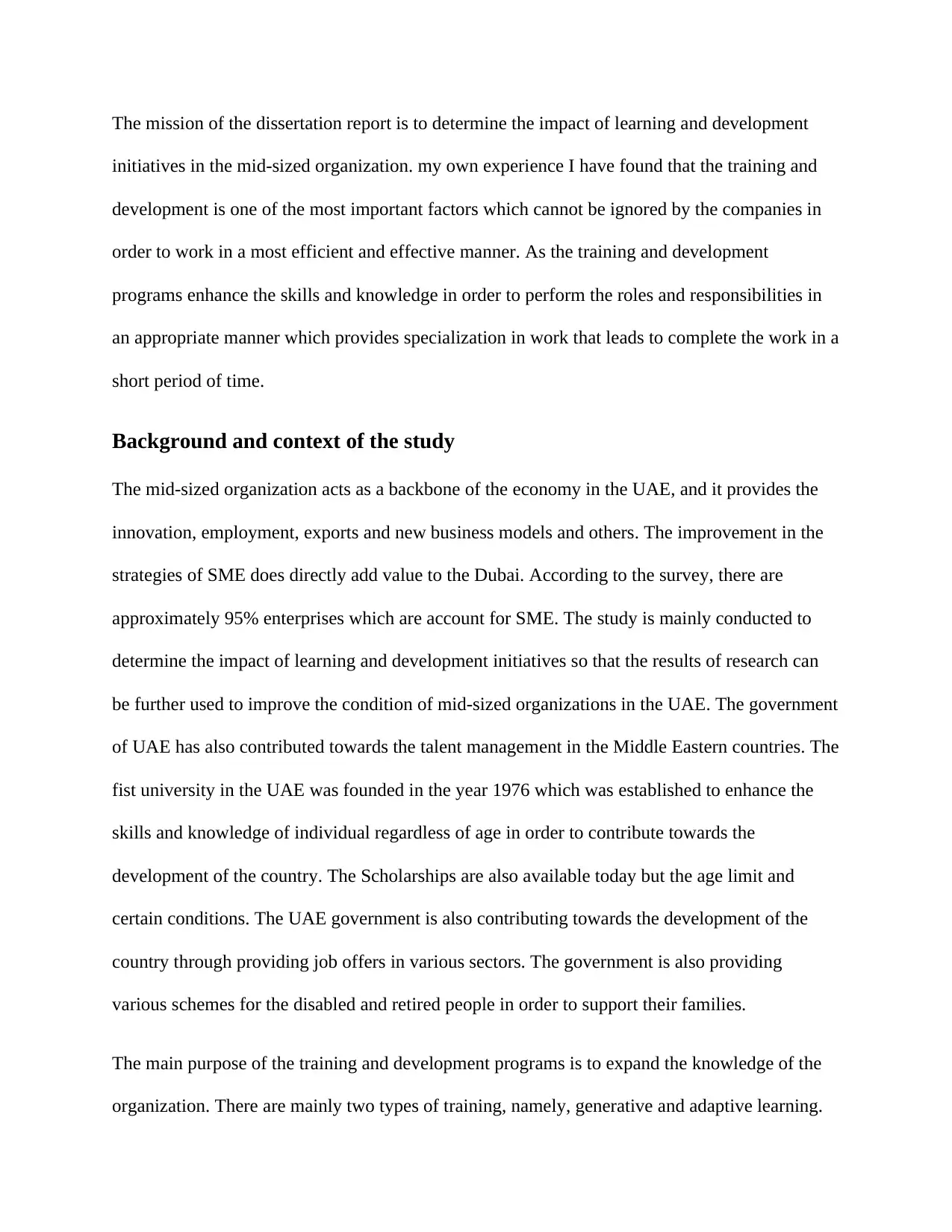
The mission of the dissertation report is to determine the impact of learning and development
initiatives in the mid-sized organization. my own experience I have found that the training and
development is one of the most important factors which cannot be ignored by the companies in
order to work in a most efficient and effective manner. As the training and development
programs enhance the skills and knowledge in order to perform the roles and responsibilities in
an appropriate manner which provides specialization in work that leads to complete the work in a
short period of time.
Background and context of the study
The mid-sized organization acts as a backbone of the economy in the UAE, and it provides the
innovation, employment, exports and new business models and others. The improvement in the
strategies of SME does directly add value to the Dubai. According to the survey, there are
approximately 95% enterprises which are account for SME. The study is mainly conducted to
determine the impact of learning and development initiatives so that the results of research can
be further used to improve the condition of mid-sized organizations in the UAE. The government
of UAE has also contributed towards the talent management in the Middle Eastern countries. The
fist university in the UAE was founded in the year 1976 which was established to enhance the
skills and knowledge of individual regardless of age in order to contribute towards the
development of the country. The Scholarships are also available today but the age limit and
certain conditions. The UAE government is also contributing towards the development of the
country through providing job offers in various sectors. The government is also providing
various schemes for the disabled and retired people in order to support their families.
The main purpose of the training and development programs is to expand the knowledge of the
organization. There are mainly two types of training, namely, generative and adaptive learning.
initiatives in the mid-sized organization. my own experience I have found that the training and
development is one of the most important factors which cannot be ignored by the companies in
order to work in a most efficient and effective manner. As the training and development
programs enhance the skills and knowledge in order to perform the roles and responsibilities in
an appropriate manner which provides specialization in work that leads to complete the work in a
short period of time.
Background and context of the study
The mid-sized organization acts as a backbone of the economy in the UAE, and it provides the
innovation, employment, exports and new business models and others. The improvement in the
strategies of SME does directly add value to the Dubai. According to the survey, there are
approximately 95% enterprises which are account for SME. The study is mainly conducted to
determine the impact of learning and development initiatives so that the results of research can
be further used to improve the condition of mid-sized organizations in the UAE. The government
of UAE has also contributed towards the talent management in the Middle Eastern countries. The
fist university in the UAE was founded in the year 1976 which was established to enhance the
skills and knowledge of individual regardless of age in order to contribute towards the
development of the country. The Scholarships are also available today but the age limit and
certain conditions. The UAE government is also contributing towards the development of the
country through providing job offers in various sectors. The government is also providing
various schemes for the disabled and retired people in order to support their families.
The main purpose of the training and development programs is to expand the knowledge of the
organization. There are mainly two types of training, namely, generative and adaptive learning.
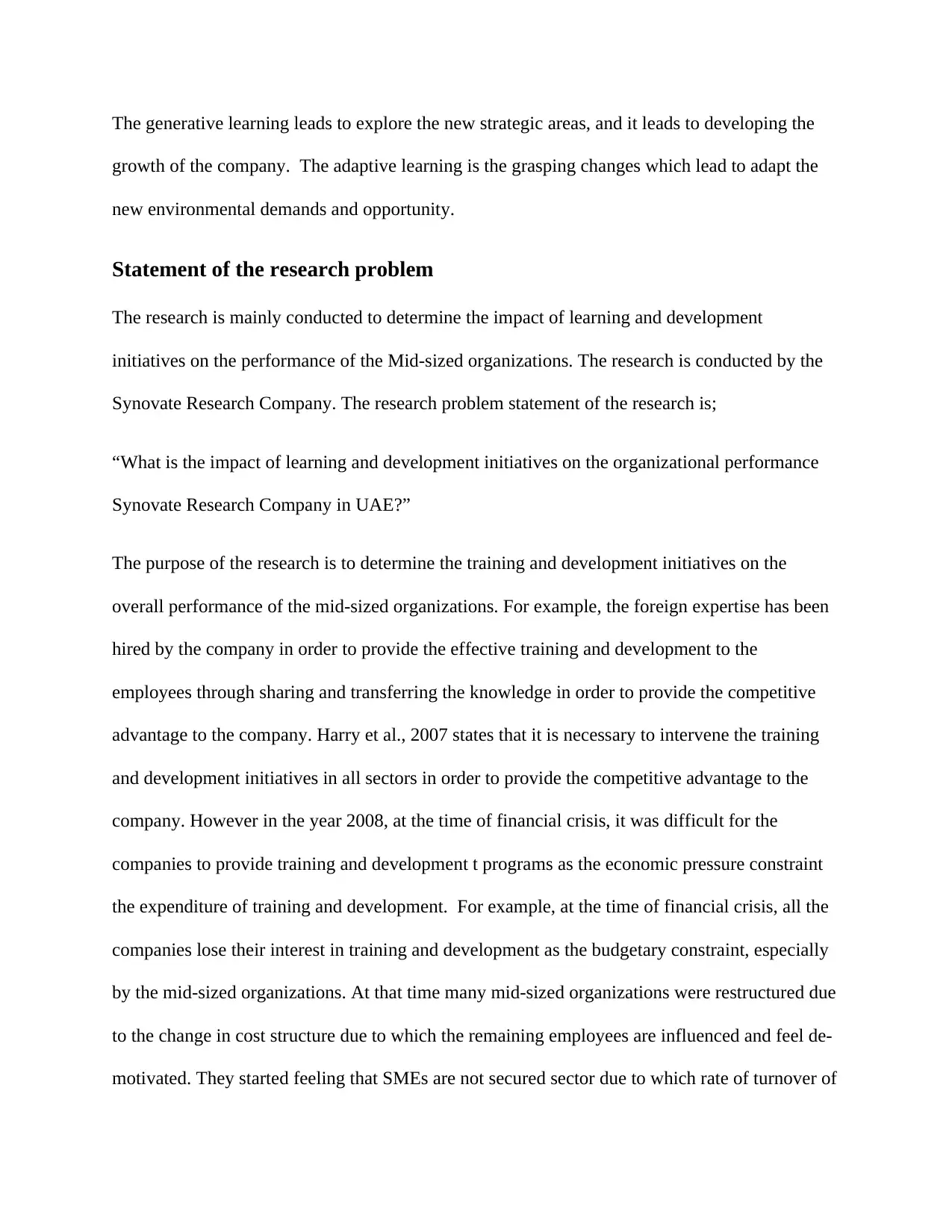
The generative learning leads to explore the new strategic areas, and it leads to developing the
growth of the company. The adaptive learning is the grasping changes which lead to adapt the
new environmental demands and opportunity.
Statement of the research problem
The research is mainly conducted to determine the impact of learning and development
initiatives on the performance of the Mid-sized organizations. The research is conducted by the
Synovate Research Company. The research problem statement of the research is;
“What is the impact of learning and development initiatives on the organizational performance
Synovate Research Company in UAE?”
The purpose of the research is to determine the training and development initiatives on the
overall performance of the mid-sized organizations. For example, the foreign expertise has been
hired by the company in order to provide the effective training and development to the
employees through sharing and transferring the knowledge in order to provide the competitive
advantage to the company. Harry et al., 2007 states that it is necessary to intervene the training
and development initiatives in all sectors in order to provide the competitive advantage to the
company. However in the year 2008, at the time of financial crisis, it was difficult for the
companies to provide training and development t programs as the economic pressure constraint
the expenditure of training and development. For example, at the time of financial crisis, all the
companies lose their interest in training and development as the budgetary constraint, especially
by the mid-sized organizations. At that time many mid-sized organizations were restructured due
to the change in cost structure due to which the remaining employees are influenced and feel de-
motivated. They started feeling that SMEs are not secured sector due to which rate of turnover of
growth of the company. The adaptive learning is the grasping changes which lead to adapt the
new environmental demands and opportunity.
Statement of the research problem
The research is mainly conducted to determine the impact of learning and development
initiatives on the performance of the Mid-sized organizations. The research is conducted by the
Synovate Research Company. The research problem statement of the research is;
“What is the impact of learning and development initiatives on the organizational performance
Synovate Research Company in UAE?”
The purpose of the research is to determine the training and development initiatives on the
overall performance of the mid-sized organizations. For example, the foreign expertise has been
hired by the company in order to provide the effective training and development to the
employees through sharing and transferring the knowledge in order to provide the competitive
advantage to the company. Harry et al., 2007 states that it is necessary to intervene the training
and development initiatives in all sectors in order to provide the competitive advantage to the
company. However in the year 2008, at the time of financial crisis, it was difficult for the
companies to provide training and development t programs as the economic pressure constraint
the expenditure of training and development. For example, at the time of financial crisis, all the
companies lose their interest in training and development as the budgetary constraint, especially
by the mid-sized organizations. At that time many mid-sized organizations were restructured due
to the change in cost structure due to which the remaining employees are influenced and feel de-
motivated. They started feeling that SMEs are not secured sector due to which rate of turnover of
⊘ This is a preview!⊘
Do you want full access?
Subscribe today to unlock all pages.

Trusted by 1+ million students worldwide
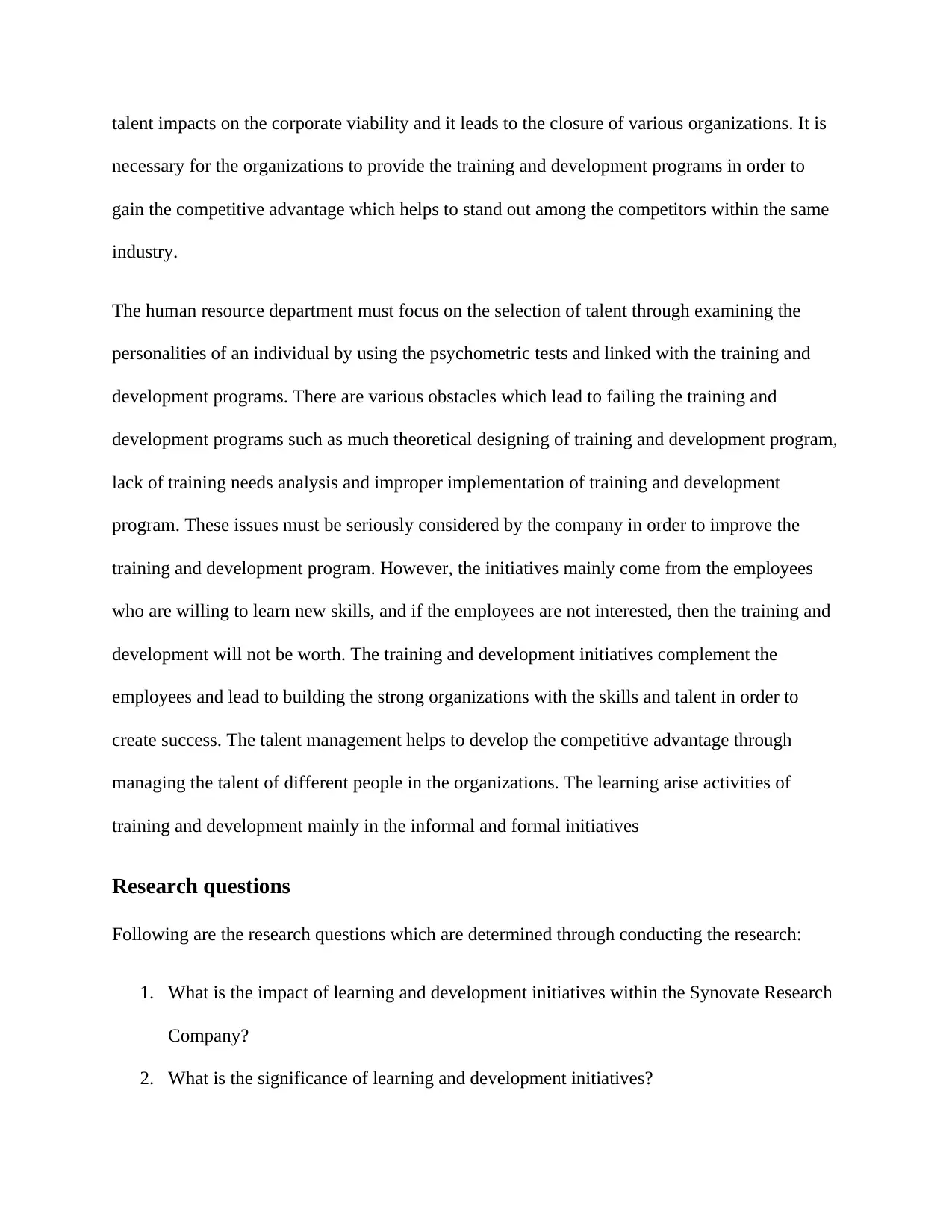
talent impacts on the corporate viability and it leads to the closure of various organizations. It is
necessary for the organizations to provide the training and development programs in order to
gain the competitive advantage which helps to stand out among the competitors within the same
industry.
The human resource department must focus on the selection of talent through examining the
personalities of an individual by using the psychometric tests and linked with the training and
development programs. There are various obstacles which lead to failing the training and
development programs such as much theoretical designing of training and development program,
lack of training needs analysis and improper implementation of training and development
program. These issues must be seriously considered by the company in order to improve the
training and development program. However, the initiatives mainly come from the employees
who are willing to learn new skills, and if the employees are not interested, then the training and
development will not be worth. The training and development initiatives complement the
employees and lead to building the strong organizations with the skills and talent in order to
create success. The talent management helps to develop the competitive advantage through
managing the talent of different people in the organizations. The learning arise activities of
training and development mainly in the informal and formal initiatives
Research questions
Following are the research questions which are determined through conducting the research:
1. What is the impact of learning and development initiatives within the Synovate Research
Company?
2. What is the significance of learning and development initiatives?
necessary for the organizations to provide the training and development programs in order to
gain the competitive advantage which helps to stand out among the competitors within the same
industry.
The human resource department must focus on the selection of talent through examining the
personalities of an individual by using the psychometric tests and linked with the training and
development programs. There are various obstacles which lead to failing the training and
development programs such as much theoretical designing of training and development program,
lack of training needs analysis and improper implementation of training and development
program. These issues must be seriously considered by the company in order to improve the
training and development program. However, the initiatives mainly come from the employees
who are willing to learn new skills, and if the employees are not interested, then the training and
development will not be worth. The training and development initiatives complement the
employees and lead to building the strong organizations with the skills and talent in order to
create success. The talent management helps to develop the competitive advantage through
managing the talent of different people in the organizations. The learning arise activities of
training and development mainly in the informal and formal initiatives
Research questions
Following are the research questions which are determined through conducting the research:
1. What is the impact of learning and development initiatives within the Synovate Research
Company?
2. What is the significance of learning and development initiatives?
Paraphrase This Document
Need a fresh take? Get an instant paraphrase of this document with our AI Paraphraser

3. What are the learning and development initiatives taken by the company?
4. What is the role of human resource management in implementing the learning and
development initiatives?
Aim of study
The aim of the research is to determine the impact of learning and development initiatives on the
mid –sized organizations through conducting the research on the Synovate Research Company.
Research objective
The purpose of the research is to stimuli the mid-sized organizations to encourage the
experimentation and collaboration within the UAE and to reap the benefits which directly benefit
the economy. The aim of the research is to understand that how human resource department can
develop the active training and development initiatives. The dissertation intends to provide the
insight that how the training and development initiatives in the UAE enable to improve the
performance of mid-sized organizations which directly contributes towards the GDP of the
country.
Following are the objectives of the research study:
1. To determine the impacts of learning and development initiatives in the organization.
2. To determine the impact of learning and development on the employee’s performance.
3. To determine the significance of learning and development initiatives.
4. To determine the role of human resource management implementing the initiatives.
4. What is the role of human resource management in implementing the learning and
development initiatives?
Aim of study
The aim of the research is to determine the impact of learning and development initiatives on the
mid –sized organizations through conducting the research on the Synovate Research Company.
Research objective
The purpose of the research is to stimuli the mid-sized organizations to encourage the
experimentation and collaboration within the UAE and to reap the benefits which directly benefit
the economy. The aim of the research is to understand that how human resource department can
develop the active training and development initiatives. The dissertation intends to provide the
insight that how the training and development initiatives in the UAE enable to improve the
performance of mid-sized organizations which directly contributes towards the GDP of the
country.
Following are the objectives of the research study:
1. To determine the impacts of learning and development initiatives in the organization.
2. To determine the impact of learning and development on the employee’s performance.
3. To determine the significance of learning and development initiatives.
4. To determine the role of human resource management implementing the initiatives.
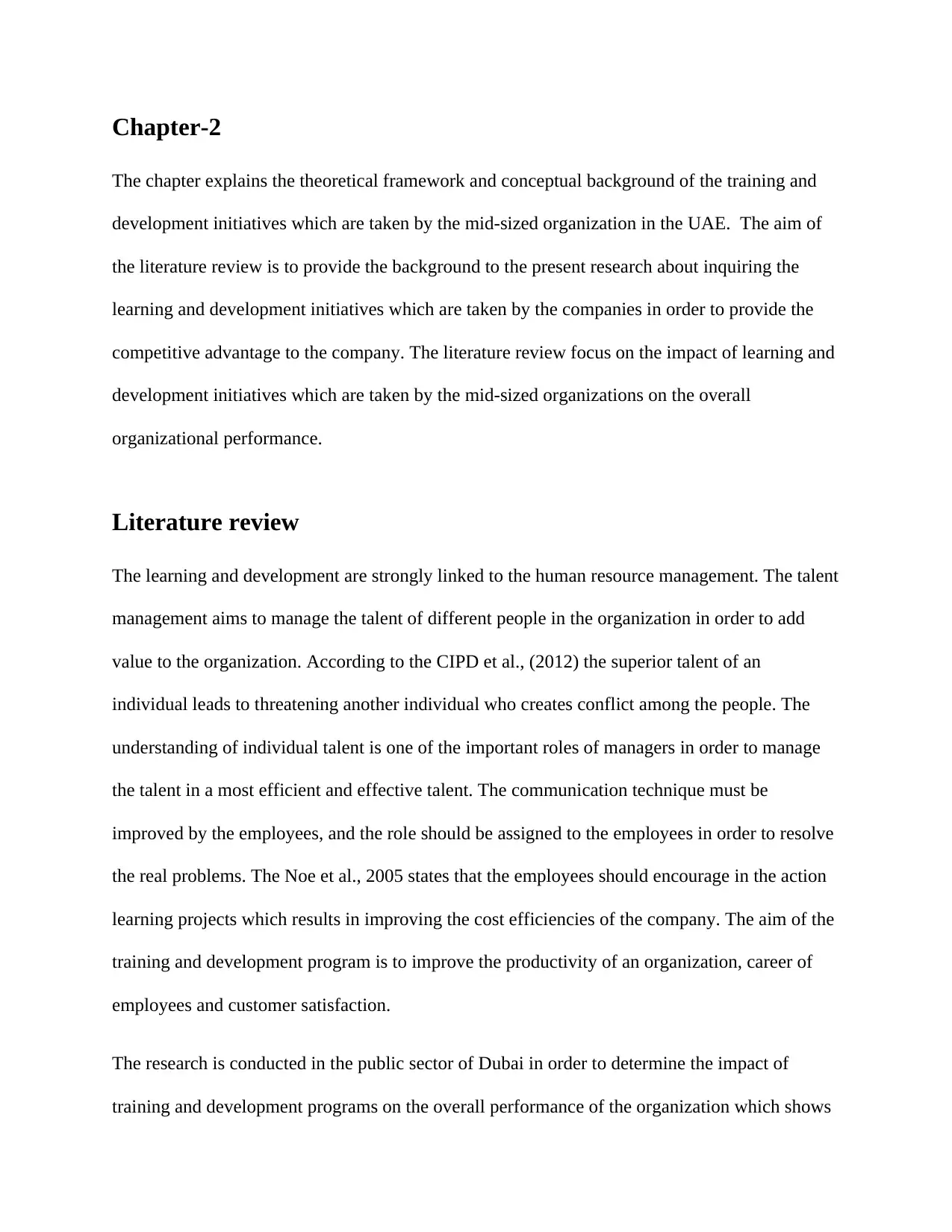
Chapter-2
The chapter explains the theoretical framework and conceptual background of the training and
development initiatives which are taken by the mid-sized organization in the UAE. The aim of
the literature review is to provide the background to the present research about inquiring the
learning and development initiatives which are taken by the companies in order to provide the
competitive advantage to the company. The literature review focus on the impact of learning and
development initiatives which are taken by the mid-sized organizations on the overall
organizational performance.
Literature review
The learning and development are strongly linked to the human resource management. The talent
management aims to manage the talent of different people in the organization in order to add
value to the organization. According to the CIPD et al., (2012) the superior talent of an
individual leads to threatening another individual who creates conflict among the people. The
understanding of individual talent is one of the important roles of managers in order to manage
the talent in a most efficient and effective talent. The communication technique must be
improved by the employees, and the role should be assigned to the employees in order to resolve
the real problems. The Noe et al., 2005 states that the employees should encourage in the action
learning projects which results in improving the cost efficiencies of the company. The aim of the
training and development program is to improve the productivity of an organization, career of
employees and customer satisfaction.
The research is conducted in the public sector of Dubai in order to determine the impact of
training and development programs on the overall performance of the organization which shows
The chapter explains the theoretical framework and conceptual background of the training and
development initiatives which are taken by the mid-sized organization in the UAE. The aim of
the literature review is to provide the background to the present research about inquiring the
learning and development initiatives which are taken by the companies in order to provide the
competitive advantage to the company. The literature review focus on the impact of learning and
development initiatives which are taken by the mid-sized organizations on the overall
organizational performance.
Literature review
The learning and development are strongly linked to the human resource management. The talent
management aims to manage the talent of different people in the organization in order to add
value to the organization. According to the CIPD et al., (2012) the superior talent of an
individual leads to threatening another individual who creates conflict among the people. The
understanding of individual talent is one of the important roles of managers in order to manage
the talent in a most efficient and effective talent. The communication technique must be
improved by the employees, and the role should be assigned to the employees in order to resolve
the real problems. The Noe et al., 2005 states that the employees should encourage in the action
learning projects which results in improving the cost efficiencies of the company. The aim of the
training and development program is to improve the productivity of an organization, career of
employees and customer satisfaction.
The research is conducted in the public sector of Dubai in order to determine the impact of
training and development programs on the overall performance of the organization which shows
⊘ This is a preview!⊘
Do you want full access?
Subscribe today to unlock all pages.

Trusted by 1+ million students worldwide
1 out of 59
Related Documents
Your All-in-One AI-Powered Toolkit for Academic Success.
+13062052269
info@desklib.com
Available 24*7 on WhatsApp / Email
![[object Object]](/_next/static/media/star-bottom.7253800d.svg)
Unlock your academic potential
Copyright © 2020–2026 A2Z Services. All Rights Reserved. Developed and managed by ZUCOL.





